Lakes make up one of the most interesting and important geographical features on the planet. They exhibit aesthetic beauty that hikers, swimmers, and tourists travel great distances to appreciate; they provide habitats for a huge array of plant and wildlife species; and they provide humans with things like drinking water, economic opportunities, and means of travel.
Ranking of Lakes by Surface Area
The largest lakes in the world have inspired humans and been centers of civilizations for millennia. In this post, we’ll look at the 15 largest lakes in the world by surface area, learning about each one along the way.
| Rank | Name of Lake | Surface Area | Countries |
| 1 | Caspian Sea | 389,000 km2 (150,000 sq mi) | Kazakhstan Turkmenistan Azerbaijan Russia Iran |
| 2 | Superior | 82,100 km2 (31,700 sq mi) | Canada United States |
| 3 | Victoria | 68,870 km2 (26,590 sq mi) | Tanzania Uganda Kenya |
| 4 | Huron | 59,600 km2 (23,000 sq mi) | Canada United States |
| 5 | Michigan | 58,000 km2 (22,000 sq mi) | United States |
| 6 | Tanganyika | 32,600 km2 (12,600 sq mi) | Tanzania Democratic Republic of the Congo Burundi Zambia |
| 7 | Baikal | 31,500 km2 (12,200 sq mi) | Russia |
| 8 | Great Bear Lake | 31,000 km2 (12,000 sq mi) | Canada |
| 9 | Malawi | 29,500 km2 (11,400 sq mi) | Malawi Mozambique Tanzania |
| 10 | Great Slave Lake | 27,000 km2 (10,000 sq mi) | Canada |
| 11 | Erie | 25,700 km2 (9,900 sq mi) | Canada United States |
| 12 | Winnipeg | 24,514 km2 (9,465 sq mi) | Canada |
| 13 | Ontario | 18,960 km2 (7,320 sq mi) | Canada United States |
| 14 | Ladoga | 18,000 km2 (6,900 sq mi) | Russia |
| 15 | Balkhash | 16,400 km2 (6,300 sq mi) | Kazakhstan |
Map of the Largest Lakes in the World
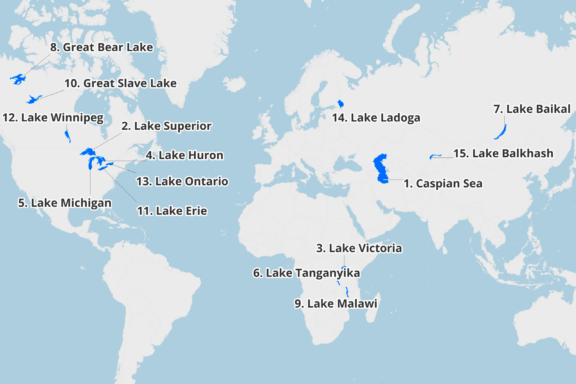
How to Define a Lake
What makes a lake a lake? Interestingly, there aren’t extremely clear guidelines when it comes to distinguishing between types of non-oceanic bodies of water. Lakes, swamps, ponds, and even some rivers have definitions that can overlap.
The most common definition of a lake is that it is a fairly large, inland body of water that is slow-moving or standing. In this post, we’ll be looking at the largest lakes in the world — there’s no mistaking these gigantic bodies of water for ponds or swamps.
15. Lake Balkhash
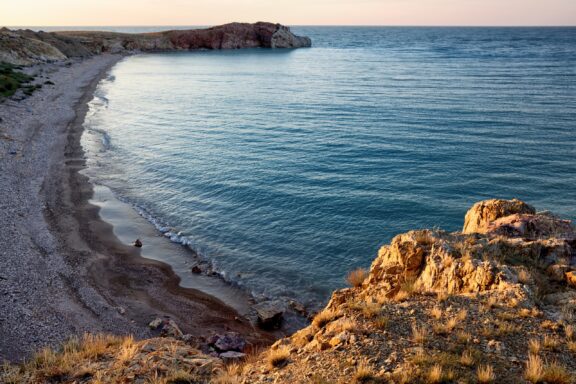
Surface area: 16,400 km2 (6,300 sq mi)
Lake Balkhash is one of the largest lakes in Asia and the 15th largest in the world, located in the central Asian country of Kazakhstan. This large lake is fed by seven rivers that drain into the Balkhash-Alakol Basin, the most significant of which is the Ili.
Although the lake has a surface area of more than 16,000 square kilometers, it is shrinking. One of the major reasons the lake is getting smaller is that China is diverting water from the Ili River to irrigate agricultural land.
Lake Balkhash is economically important to Kazakhstan and the millions of people who live near the lake, mostly because of fishing opportunities. The fishing industry has been in decline in recent history due to poor water quality and poaching.
14. Lake Ladoga
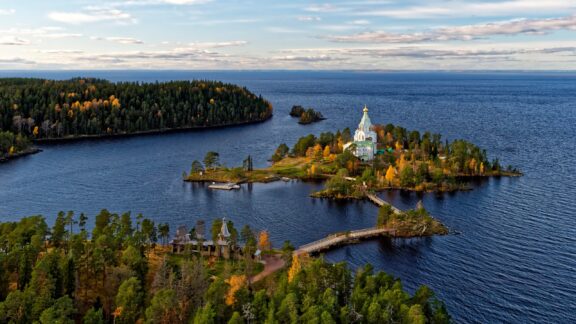
Surface area: 18,000 km2 (6,900 sq mi)
Russia’s Lake Ladoga is notable for being the largest lake located entirely in Europe. It’s situated in northwestern Russia near St. Petersburg and is fed by more than 50 rivers. The Neva River drains the lake and flows through St. Petersburg into the Gulf of Finland.
As home to nearly 50 types of fish, Ladoga is rich in biodiversity. The presence of so much wildlife once made the lake a major commercial fishing center, but overfishing of valuable species has since hurt the industry.
In addition to its economic value, Lake Ladoga has had geostrategic importance for many years. It has served as a vital trade and military transportation route for much of Russia’s history. The lake played a central role in the Siege of Leningrad in World War II and became part of the USSR after the war.
13. Lake Ontario
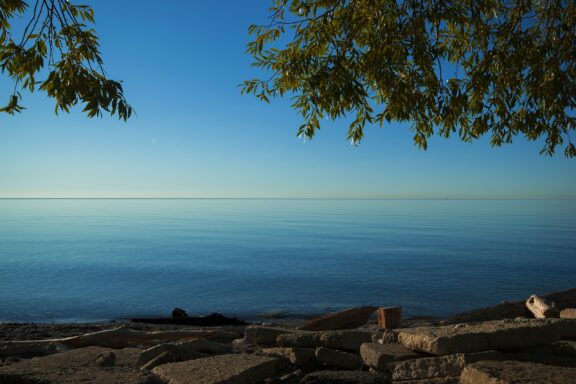
Surface area: 18,960 km2 (7,320 sq mi)
The 13th largest lake in the world is Lake Ontario, which gets its name from the Canadian province it borders. The lake also borders the US state of New York, with the US-Canada border stretching across the center of the lake.
Lake Ontario is the smallest of the lakes that make up the North American Great Lakes region and has a rich human history. It was a vital waterway for Indigenous peoples before European explorers navigated the waters and early settlers eventually populated the area.
Today, Lake Ontario is a major source of fresh water for millions of people. It’s also a popular location for recreational water sports like boating, fishing, and swimming.
12. Lake Winnipeg
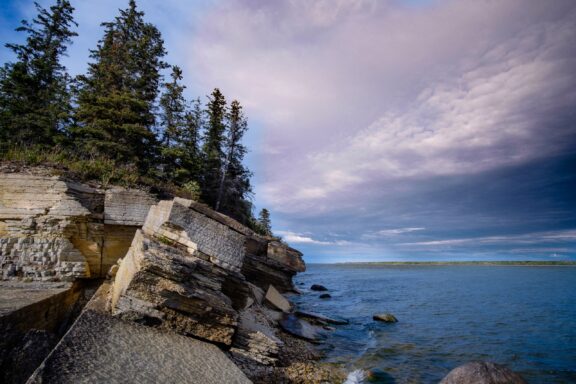
Surface area: 24,514 km2 (9,465 sq mi)
Lake Winnipeg is one of three lakes on this list that are located entirely within Canada. It’s located in Canada’s Manitoba province and covers an amazing 24,514 square kilometers. The lake is relatively shallow, maintaining a mean depth of 12 m (39 ft), and it stretches for 416 km (258 mi) from north to south.
Beautiful beaches line this lake, which helps to make it a popular recreational destination. The boreal forests that run along the lake make up part of the Pimachiowin Aki, the ancestral home of the Anishinaabeg and a UNESCO World Heritage Site.
11. Lake Erie
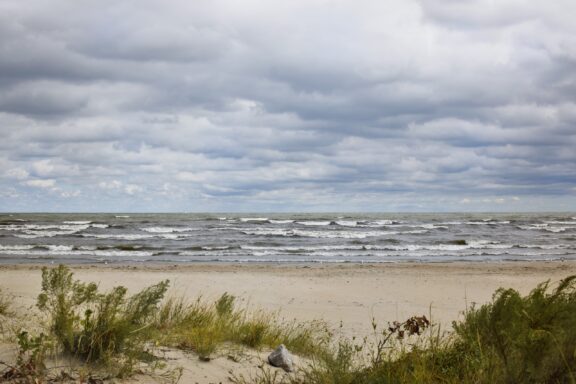
Surface area: 25,700 km2 (9,900 sq mi)
Another of the Great Lakes in North America, Lake Erie is situated across the US-Canada border and is the 11th largest lake in the world. The lake is a significant freshwater source for people in both countries, and several ports and harbors facilitate international trade.
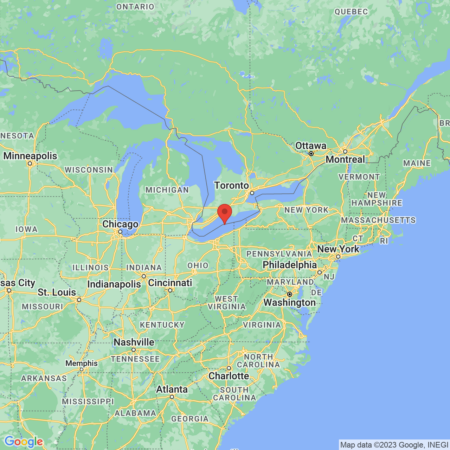
The long coastlines of Lake Eerie contribute to its complex ecosystem, which is affected by human activity such as pollution and maritime traffic. Many invasive species, some thought to have traveled in the ballast water of international ships, have also presented problems for the lake’s ecosystem.
10. Great Slave Lake
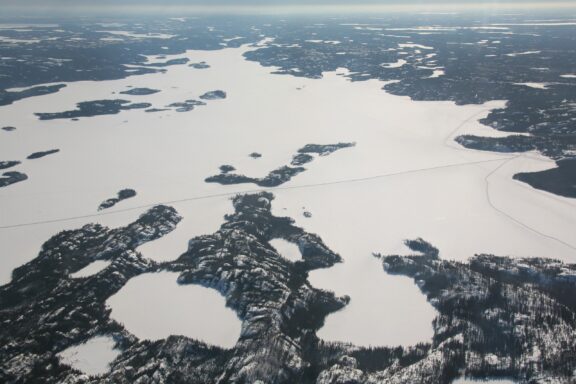
Surface area: 27,000 km2 (10,000 sq mi)
This is another of the world’s largest lakes located entirely within Canada. The Great Slave Lake gets its name from the Slavey First Nations indigenous peoples of the Dene group. Indigenous peoples have inhabited the area around the lake for at least 8,000 years, and it didn’t appear on European maps until the middle of the 18th century.
In addition to its vast size, the lake is known for its rugged beauty and unique ecosystem. Low levels of pollution and few invasive species give the lake rich aquatic life. There are large numbers of lake whitefish that thrive here, along with many other species of fish.
9. Lake Malawi
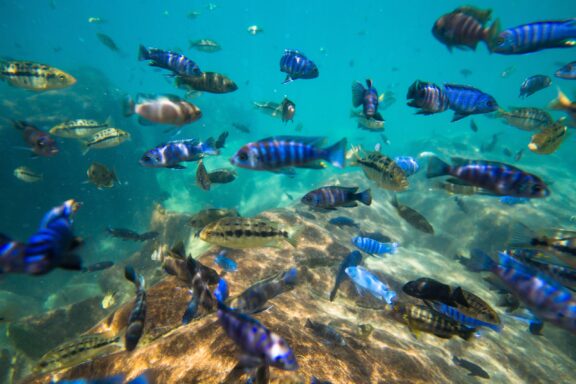
Surface area: 29,500 km2 (11,400 sq mi)
Lake Malawi is located in southeastern Africa. It’s one of the largest lakes in Africa and is part of the African Great Lakes region, shared by Malawi, Mozambique, and Tanzania. However, there is a border dispute between Malawi and Tanzania — Malawi claims all of the lake’s surface that is not in Mozambique, and Tanzania claims the international border runs through the center of the lake.
One of the most interesting features of Lake Malawi is that it has the most fish species of any lake in the world. Its clear waters are home to cichlids, which are endemic species of fish, and larger animals like crocodiles, monkeys, and hippopotamuses also live at the lake.
8. Great Bear Lake
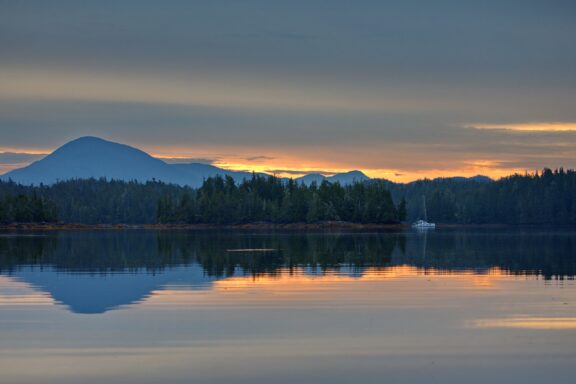
Surface area: 31,000 km2 (12,000 sq mi)
The Great Bear Lake is the largest lake located entirely in Canada, situated in the Northwest Territories. Lying on the Arctic Circle between 65 and 67 degrees northern latitude, it is the northernmost lake on this list. The lake’s remote location means it has been largely unaffected by humans and retains a high level of natural beauty.
This lake has been culturally important for various indigenous peoples, and its shores are home to the Délı̨nę community. One of the prophecies of a Délı̨nę prophet named Louis Ayah suggests that at the end of the world, what remains of humanity will gather at the shores of Great Bear Lake.
7. Lake Baikal
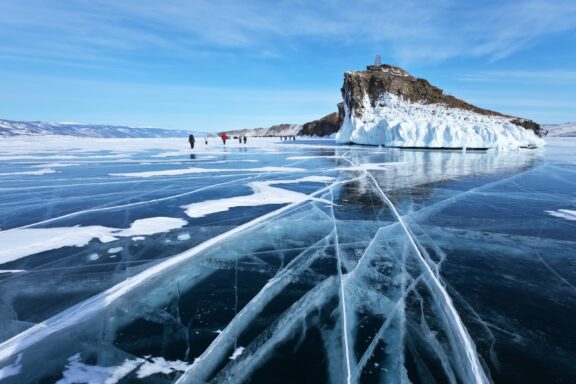
Surface area: 31,500 km2 (12,200 sq mi)
Lake Baikal is located entirely in Russia and is famous for being the oldest and deepest lake in the world with a maximum depth of around 1,700 meters (5,577 feet). Although there are six lakes with larger surface areas, Lake Baikal’s great depth makes it the largest freshwater lake by volume.
Situated in southern Siberia, the lake’s isolated location is partly responsible for the unique fauna that lives in and around the lake. More than 80% of the species living around Lake Baikal are endemic to the area.
The lake’s tourism potential has attracted investors in the past who have constructed hotels along its shores.
6. Lake Tanganyika
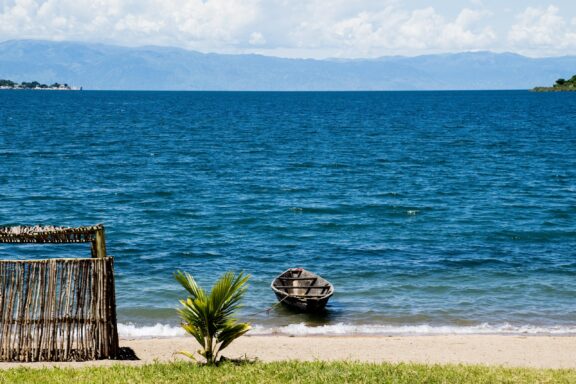
Surface area: 32,600 km2 (12,600 sq mi)
This is the second-deepest lake in the world, and it is located in East Africa. Lake Tanganyika is shared by four countries: Tanzania, the Democratic Republic of Congo, Burundi, and Zambia. It empties into the Congo River, which eventually leads to the Atlantic Ocean.
One origin story of the lake’s name is that it was called “êtanga ‘ya’ni’â,” which translates to “big river” in English, by the Bembe people when Welsh-American explorer Henry Morton Stanley arrived in 1876.
Tanganyika is host to some interesting wildlife and geological features, thanks in part to its impressive depth. There are as many as four types of Nile Perch, one of the largest freshwater fish in the world, that live here.
5. Lake Michigan
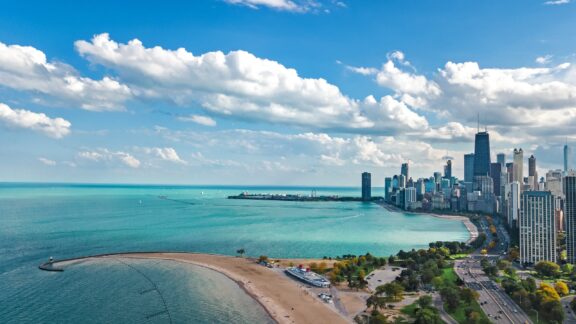
Surface area: 58,000 km2 (22,000 sq mi)
The third largest of the North American Great Lakes by surface area is Lake Michigan, which is the only Great Lake to be located entirely in the United States. The sandy beaches and great size of this lake make it a popular tourist destination for recreational activities like swimming, fishing, and boating.
Some of the first humans to inhabit the area around Lake Michigan were the Hopewell Native Americans. When Europeans arrived in the 17th century, the descendants of Woodland Native American tribes such as the Chippewa, Menominee, Sauk, Fox, Winnebago, Miami, Ottawa, and Potawatomi were living in the area.
4. Lake Huron
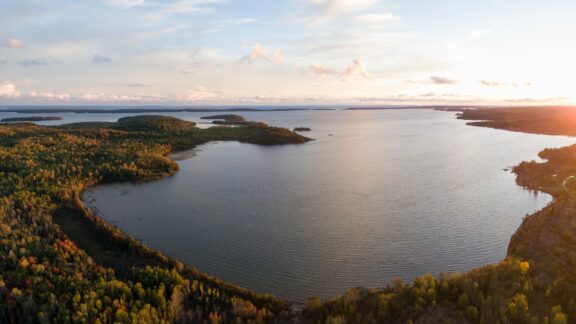
Surface area: 59,600 km2 (23,000 sq mi)
Lake Huron is the fourth largest lake in the world and is located between the United States and Canada in the North American Great Lakes region. In hydrological terms, it actually forms one massive lake with Lake Michigan, but they are otherwise considered two different lakes.
The lake gets its name from the indigenous Huron people who were present when French explorers arrived during the 17th century. Since Europeans began sailing on the lake around the same time, the lake has gained a reputation for its many shipwrecks. Well over 100 of these wrecks can be found in the lake’s Thunder Bay alone.
3. Lake Victoria
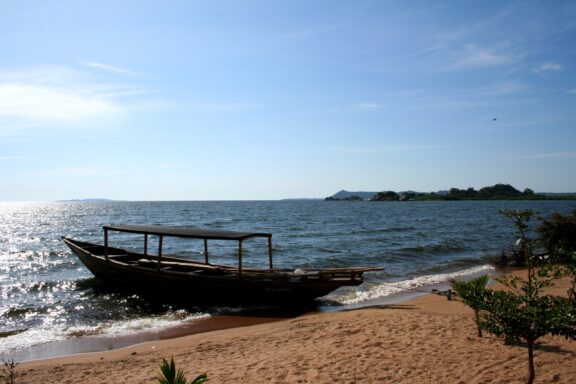
Surface area: 68,870 km2 (26,590 sq mi)
Lake Victoria is the largest lake in Africa and the largest tropical lake in the world. The lake is a dominating feature in the region and provides many people with drinking water, food, and means of transportation. Ferries on the lake have provided transport between Uganda, Tanzania, and Kenya for over 100 years.
A wide range of mammals, reptiles, and fish call Lake Victoria home, and it is the site of Africa’s largest inland fishery. Fishing remains a large industry on the lake, but overfishing and the introduction of invasive species have contributed to the extinction of many of the lake’s endemic species.
2. Lake Superior
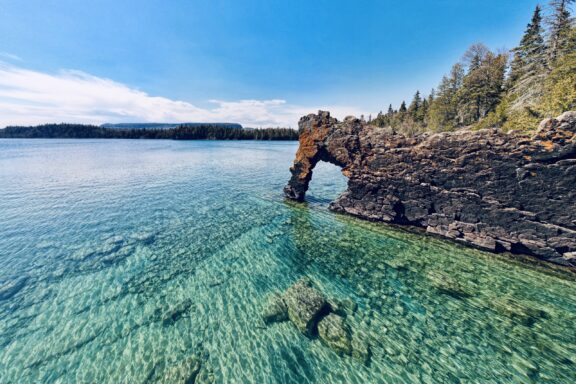
Surface area: 82,100 km2 (31,700 sq mi)
Lake Superior is the largest freshwater lake in the world. It’s located in both the United States and Canada, and its surface area covers an incredible 82,100 square kilometers. The lake’s current name is an anglicized version of le lac supérieur, as named by French explorers. The Obijwe name for the lake is gichi-gami, which translates to “great sea.”
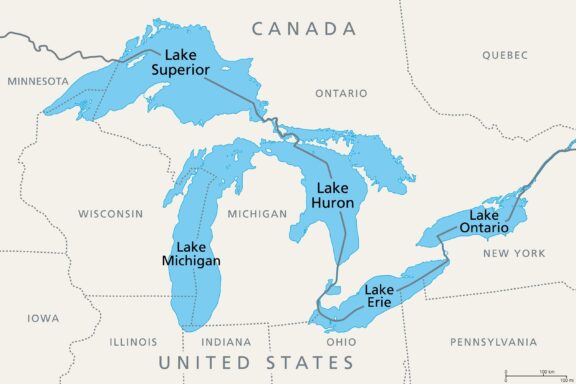
Known for its clear waters, Lake Superior is often considered the healthiest of the North American Great Lakes. The high visibility and presence of many shipwrecks make the lake a prime recreational diving locale.
1. Caspian Sea
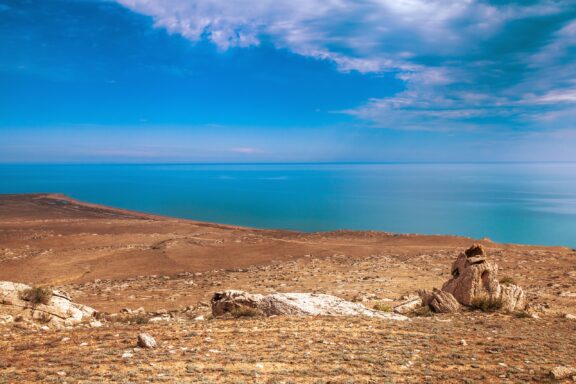
Surface area: 389,000 km2 (150,000 sq mi)
The largest lake in the world is the Caspian Sea, located between Europe and Asia. Whether the body of water is a sea or a lake is up for debate and has political implications, but there’s no debating its gigantic size. Although the Caspian Sea is not freshwater, it is not connected to the world ocean, and it has lower salinity than the ocean.
As a major source of oil and gas reserves, and as a link between Europe and Asia, the Caspian Sea holds great economic and geopolitical importance. There are also many rare and endemic species that live in or near the sea. Iran’s largest UNESCO World Heritage Site, the Hyrcanian Forests, is located along the southern shore of the Caspian Sea.
More About the World’s Largest Lakes
Where are the largest lakes located?
The largest lakes in the world are found all over the globe, but there is a higher concentration of the biggest lakes found in Africa and North America. The North American Great Lakes region was created by glacial activity, and the Great Lakes of Africa were created through the movement of tectonic plates.
Why are large lakes important?
The world’s great lakes provide many benefits to humans and their environments. They are often home to a wide range of plant and animal species, sometimes hosting many endemic varieties. Scientists are able to learn a great deal about our life on our planet by studying these ecosystems.
Large lakes also provide economic opportunities in the form of tourism and natural resources. They often support a major fishing industry and are sometimes sources of oil and natural gas.
What are some threats to the world’s largest lakes?
The world’s largest lakes are threatened by human impacts such as overfishing or overdevelopment, climate change, and invasive species. All of these can contribute to the deterioration of a lake’s ecosystem.